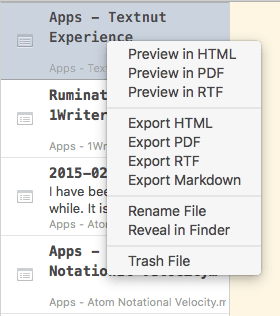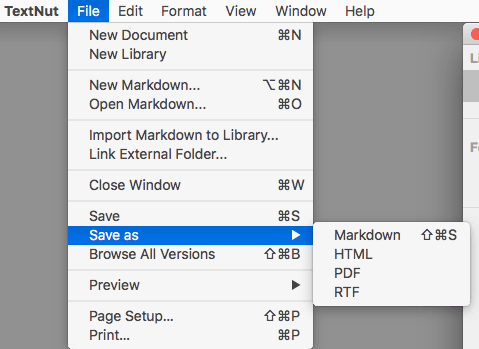Review of TextNut
 TextNut icon
TextNut icon
Product: TextNut
Price: Regular $34.99 On sale for $16.99
TextNut is at its base a text editor which supports CommonMark. CommonMark is an attempt at a standardized Markdown specification. At this point, there are two editors, which I know of, which are based on CommonMark, this one, TextNut, and Versatil Markdown. I am going to talk about Versatil Markdown in a later post.
Who are the competitors of this product?
It competes with Write for Mac. It has an advantage over Write for Mac, in that the development on Write has ceased. It competes with Ulysses. It also competes with the various note-taking programs like Katana - Note app for Mac OSX, nvALT - BrettTerpstra.com, and a host of others who have been playing in that space.
I am not going to talk about Write for Mac in this review. It saddens me that a very well designed product has been essentially abandoned by the developer. I cannot recommend it anymore and so we are going to keep it out of this review.
The main distinction between the various note-taking programs and TextNut is that the alternatives only have the ability to manage one folder of text files. TextNut manages as many folders as you want. It is very similar to the model Ulysses uses. You can create, edit and manage documents which reside in its Library or you can add folders from your Mac. You can create, edit and manage files in these folders on your Mac. I didn't find any major differences in the way TextNut handles its own library files and the external folder files. This ability of TextNut to handle multiple folders of text files from your Macintosh hard drive immediately differentiates it from the competition.
WYSIWYG Environment
TextNut tries to hide you from Markdown by its implementation of what it calls a WYSIWYG markdown editing environment. You style the text as you want and it incorporates the markdown code around your styles. For those, who are starting out with markdown, this is not a bad workaround. For others, who are comfortable with markdown, this is unnecessary. Considering that markdown in its basic implementation is pretty easy to pick up, I am not sure that this feature has too much traction. But it is a solution for those who are not comfortable with markdown and it lets them write and then their content is seamlessly converted to markdown and that must appeal to some people. TextNut lets you switch between its WYSIWYG mode and markdown mode on the fly and that is a convenient feature if you are interested in previewing your markdown document.
Language Syntax Highlighting
TextNut is a tad confusing when you consider that it provides a WYSIWYG environment for markdown novices but provides full syntax highlighting in its implementation of code blocks. Wouldn't the writer who is familiar with code, also find it easy to learn markdown? It is a nice touch for those who pepper their markdown documents with code snippets. For the rest of the users, it is not a feature which is very useful. But you do get full syntax highlighting for your code snippets, and it does support a plethora of languages.
Easy Document Management
The ability to handle documents both in its internal library and in external folders is a feature shared by TextNut with Ulysses. It makes handling a whole bunch of text files easier. You can drag and drop files from one folder to the other, you also have the ability to preview, export, rename or reveal in Finder right from the sidebar files you have in an external folder. In the Library folder, files cab be previewed, exported or deleted to trash.
 Document management
Document management
One significant difference between TextNut and Ulysses is that TextNut doesn't support iCloud. TextNut doesn't have a corresponding iOS version, so it doesn't need to do that. Your files in TextNut are all residing on your computer: some in the TextNut Library and some in folders on your Macintosh. If you are looking for a cloud backup, you can add folders from your Dropbox folder, or any cloud folder, and TextNut handles them fine.
In this category, the ability to handle multiple folders is much requested. Users have their own organization schema and they like it when a note-taking program can handle all their notes from different folders rather than forcing them to use one folder for all their notes. Ulysses does provide the same ability. Solutions like nvALT, and Katana, do not.
TextNut provides a tagging ability within the program. These are not shared with the Finder, so it is a tagging system unique to the product itself. You add tags to your document in the following form +tag+ +tag2+ and so on. It is a nice system, which is useful if you decide to do a lot of your writing in TextNut. Interestingly, and I do not know whether this is a bug or not, tags only work in files which are in the TextNut Library. If you add tags to your files which reside in external folders, TextNut records them in the Tags but it doesn't let you jump to the file by clicking on it. Files which are in the TextNut Library are easily reached by just clicking on them in the Tags document.
 Tagging
Tagging
Ulysses implements tags differently. You can assign keywords to your documents, and they can be searched. Ulysses also suffers from the same bug/feature in that tags are accessible when they are in the iCloud folder or in its internal library, but not external files.
Themes
TextNut provides you the ability to use themes. It ships with six themes and you can duplicate and modify them to your hearts content. Unlike Ulysses it doesn't let you export your creations and share with the world. Ulysses provides more fine-grained control in your theme design while TextNut is adequate in its implementation.
 Themes
Themes
Export
You can export your content from TextNut as markdown, html, PDF or RTF. Those are the usual standard options and TextNut does a decent enough job in that regard. It doesn't hold a candle to Ulysses's output skills though. It doesn't let you define the formatting of your output. It doesn't do epub's and it is severely constrained when you consider the choices Ulysses provides in this space. TextNut lets you get the content out of the program but doesn't let you do anything interesting with it. It is sufficient but not competitive with Ulysses.
 Export
Export
Ulysses is conceptualized as a writing and publishing solution, and that explains the control over its output. TextNut is a basic note-taking program and is not overtly concerned with providing you fine-grain control over your output.
Zen Mode
I don't see the benefits of Zen mode. It does not include typewriter scrolling. It is just an attempt to take away the chrome from your editing window. In zen mode, the title bar disappears and the sidebar disappears. Seems to me that this is a pretty standardized implementation in almost all of these markdown based editors. Byword, iA Writer, and a whole host of its competitors do a much better job of providing an environment for you to write in. Zen mode in TextNut is an imperfect and incomplete implementation of an old idea. Ulysses the main competitor to this product does this in much more innovative ways.
Again, it seems to me that TextNut is aware of a feature in this space, but doesn’t care enough to implement it with any degree of precision or thought. If you have a three-panel application, it is not at all unusual to hide two of the panels and focus on the editor panel. Every application in this space does this. Calling it “zen mode” is just marketing hogwash and lazy. There is nothing zen about this mode. Just hiding the chrome around the window and the panels doesn’t equate to any zen you are going to be happy in. How could this be improved? Add typewriter scrolling, focus on sentence or paragraph, let me implement typewriter scrolling at any point I want. Try to provide an environment which lets me write better: then you can call it zen.
Advanced Markdown Styles
Like Ulysses, TextNut supports lists, blockquotes, codeblocks, images, footnotes and the like. The one thing that TextNut covers which Ulysses doesn't is Tasks. It is a not a part of the CommonMark Specifications, it is an addition from TextNut. If you are looking to manage a list of tasks amongst your text files it is not a bad solution. In fact, this is one feature which this program has implemented that is not available from its competitors. Erato, through its support of Github flavored markdown also provides a task list implementation, but Ulysses or Katana doesn’t.
Conclusions
TextNut is a nice addition to the arsenal of note-taking apps. It brings the ability to handle multiple folders. It provides some nice touches, WYSIWYG markdown editing, CommonMark specifications, an underwhelming zen mode, and Filters & Tags. If you take your writing and note-taking seriously, you are better off with Ulysses. It is just better at providing a writing environment for the user. If you are resource constrained, TextNut is not a bad choice, specially at the reduced price point.
macosxguru at the gmail thingie